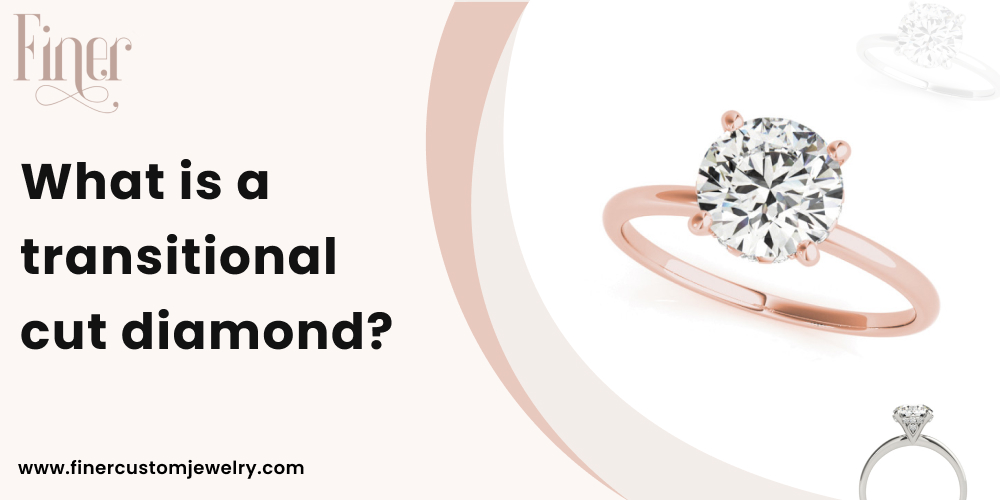
Have you ever heard about a transitional cut diamond and are excited to know more about this historical diamond cut?
The transitional cut is a classic style that was only popular for a few decades. Its scarcity has led some to believe it is merely a fable, as there is no GIA transitional cut in existence today. The European Cut was evolving in the early twentieth century, and its evolution led to the birth of the Transitional Cut.
Transitional cut diamonds, also known as Early American Cuts or Early Modern Cuts, are unique. The transitional cut evolved from the traditional European cut. It’s a traditional beauty with a round-cut, large table, low crown, small culet, and short Pavillon.
The shift of diamonds from the old round brilliant cut to the present round brilliant-cut took roughly twenty to thirty years. As a result, many stones cut at that time are referred to as Transitional Cuts. Bigger tables (larger tables were supposed to promote brilliance) and little open culets were common. Although the crown angles were reduced, the pavilion facets remained comparable to the Old European Cuts.
Transitional cuts had a crown similar to modern cut stone, but a pavilion akin to an old European cut stone, albeit with a smaller culet. The famed checkerboard pattern, which is one of the most stunning elements of the transitional cut and is certainly a sight to witness, can be seen in some stones. While these unique cuts are often associated with antique or vintage pieces, those looking for affordable diamond rings Scottsdale offers might find that some jewelers incorporate elements of these transitional cuts in modern designs, providing a blend of historical charm and contemporary affordability.
GIA established the “Circular Brilliant” in 2014, which includes several Transitional Cuts in their classification. A true transitional cut, regardless of GIA, has its personality as one of the most important cuts in diamond history. When exploring Phoenix’s finest diamond rings, you might encounter pieces featuring these unique transitional cuts, offering a blend of historical significance and modern brilliance that appeals to those who appreciate both the artistry of vintage diamond cutting and contemporary jewelry design.
In the 1920s, with the emergence of modern technologies, an endeavor to manufacture a uniform round cut diamond began to take shape. The old European diamond began to “transition” to the transitional cut diamond.
From the 1930s to the 1940s, transitional cut diamonds were most popular in jewelry. For those seeking expert guidance on these vintage styles, Tempe diamond rings specialists offer valuable insights and assistance in selecting the perfect piece.
The goal was symmetry and uniformity, but diamond cutters were still doing most of their work by hand at the time. Transitional diamonds, on the other hand, were cut with shifting proportions, angles, and faceting criteria. In comparison to the previous old Euro, they had larger tables, a lower crown, and a smaller culet. For those looking to learn more about these intricate details, a Diamond auction guide can provide invaluable information and insights into the unique characteristics and historical significance of transitional cut diamonds.
The transitional cut diamond is a cross between the massive old Euro diamonds of the past and today’s dazzling stones. These beauties have an old-world vibe to them while still retaining their ultra-modern round bright shine.
The original round was a late-nineteenth-century European cut that became fashionable. Small tables, steep crowns, fat pavilion faceting, and huge culets were prominent features of these stones. If you possess such historical diamonds and are considering selling, remember that at Finer Custom Jewelry, we buy your diamond and gold jewelry, ensuring you get the best value for your treasured pieces.
The transitional cut diamond spanned this gap by adopting proportions that resembled current round brilliants but were not standardized. As previously said, they come in a variety of shapes.
Transitional cuts are ancient, but the closest cut to the transitional cuts are brilliant round cuts. Buy amazing diamond jewelry with the help of experts from Finer Jewelry.
Do you have a vision for your custom engagement ring, but aren’t sure how to make it a reality? Allow us to guide you through the process of how to create truly exceptional rings. Schedule your design appointment today and see how Finer Custom Engagement Rings and Diamonds will bring your vision of an engagement ring to life.
© Copyright Finer Custom Jewelry 2024